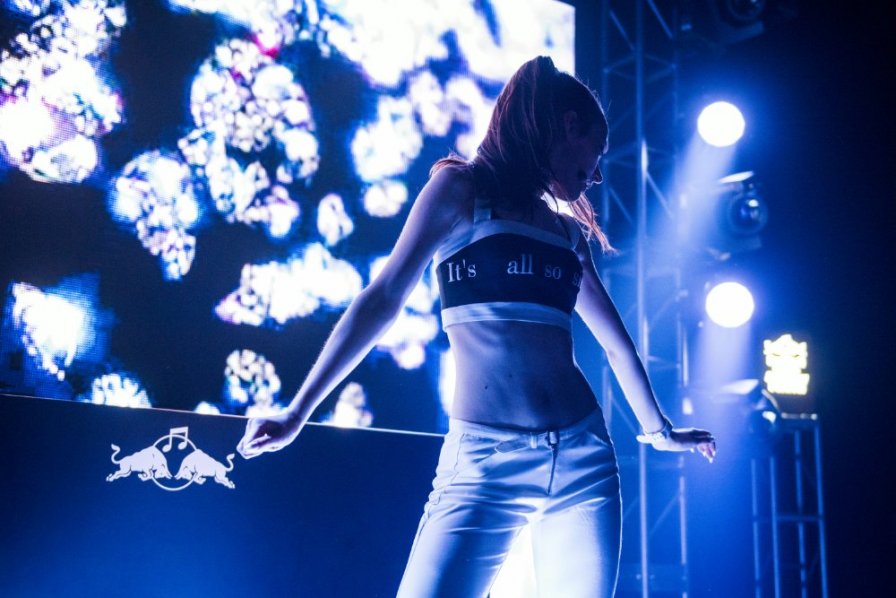For the entire month of May, the Red Bull Music Academy has brought another incredible series of performances, club nights, lectures, and workshops to New York. In addition to a performance by FKA Twigs and conversations with A$AP Rocky and George Clinton, RBMA also put on the following showcases:
- Pop Cube: PC Music & SOPHIE
- Nothing Changes: Raw Sound Transgression: Merzbow, Genesis P-Orridge & Aaron Dilloway (performing Electric Newspapers), Pharmakon, Prurient (performing Pleasure Ground), Ron Morelli, Marshstepper, Uniform
- Tri Angle Records 5th Anniversary: The Haxan Cloak, Evian Christ, Holy Other, Forest Swords, Vessel, mssingno, Boothroyd, Lotic, Rabit, Hanz
- GHE20G0TH1K: Sissy Nobby, Venus X, Ma Nguzu, Mike Q, Divoli S’Vere, Total Freedom + special guests (hosted by Hood by Air)
- Electronic Africa: Nozinja, Titica, DJ Spoko, Chief Boima, Dubbel Dutch
- A Conversation with La Monte Young
Tiny Mix Tapes sent four writers — C Monster, SCVSCV, Adam Devlin, and Jeffrey Dunn Rovinelli — to cover these events, which included a surprise set by Björk, a talk by the “daddy of us all,” and a white Cadillac SUV stretch limo.
Tri Angle Records 5th Anniversary
 Rabit
Rabit
Through a new slew of releases, the grander curatorial mission of Tri Angle Records has shifted into focus, revealing (to me) the genius of their project — curating the cohesion between razor-sharp personal visions of their individual artists with a larger, visible grandiosity. Perhaps such grandiosity finds its perfect avatar in Björk; the songstress has naturally gravitated toward the cold, exhilarating, modern aesthetic Tri Angle has been proliferating. Through the Haxan Cloak’s production credits on Vulnicura and a “courtship” of remixes and guest radio appearances, it seemed Björk’s involvement with Tri Angle was hinted at as a set-up for her revelatory appearance at their fifth anniversary show. Yes, Björk skittered up on the smaller of two stages, essentially a sweaty garage, to deliver a full DJ set looking like a champagne-sipping, black leather-clad ice-demon armed with CDJs and a jeweled Givenchy-style mask. Her set came after a sharp performance from Tri Angle newcomer and TMT favorite Hanz, who dropped incisive, heady breakbeats that called to mind angry DJ Shadow tracks sliced apart by a ronin-warrior with Hanzo-grade steel.
The introverted, entrancing nature of his set nonchalantly led up to Björk (slipping into a time-slot billed as label head Robin Carolan). She delivered a heavy polymerization of world female vocals, culled from Sufi and Fado acapellas that freely danced over deep, aggressive club cuts — Bloom, Rabit, Vessel, and Lotic among them. The smaller room was by far more energetic than the main stage; I found myself drifting away during lumbering, sleepy sets by Holy Other, Forest Swords, and found my ears splitting during the Haxan Cloak’s brutal dirges. Yet, it was Lotic who stole the show, even outmatching the GHE20GOTH1K squad’s liberation tactics by delivering an inspirational performance that saw him dancing on the table amidst hunky, shirtless dancers (Total Freedom among them) who were blissing out to Lotic’s violent beat-craft and entrancing, vogue-like hand movements. By the time Evian Christ came to the main stage many were scurrying out during Lotic’s final moments; yet, Christ’s big, over-inflated beats paled in comparison to the sweaty, floor-focused energy of Lotic. The event took place in the basement of a former JP Morgan bank on Wall street, both stages flanked by a giant steel vault that reverberated the evening’s ever-present sub-bass. It was a fitting location, as metallic, dark beats seemed to be overtaking and even representing a vision of abandoned post-capitalism where new idols are celebrated ritualistically in the basements of destroyed banks.
Nothing Changes: Raw Sound Transgression
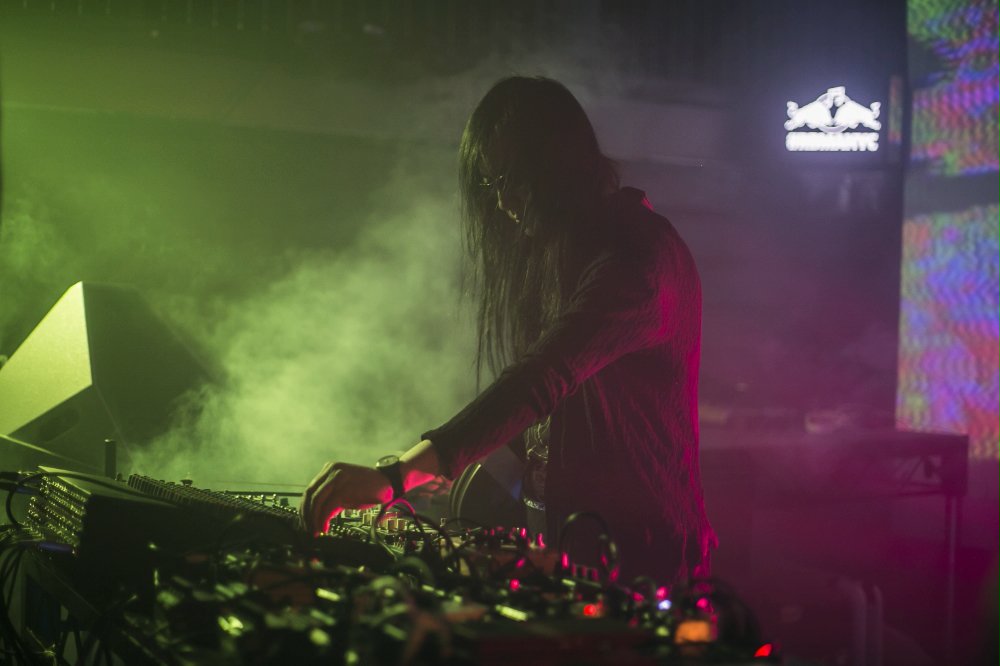 Merzbow
Merzbow
Red Bull’s now-annual and consistently well-curated noise showcase is as perversely well-suited to the corporate behemoth’s purview as PC Music’s accelerationist pop-commericalism, albeit in shrieking inverse. With this year’s installment at Williamsburg lux dance haven Output, the soda-sponsored set scanned as a seething expression of the creeping anxiety and instability that accompanies a hyper-corporatized environment, the dystopian impulses of many of the assembled artists run through a concert environment that began with a 45-minute line for ticket holders paying $25 a piece, followed by a more-invasive-than-TSA pat down, $4 coat check and $12 well drinks, and prowling security squad that was both polite and consistently in the way. If last year’s installment focused on overt forms of social control through police officer’s attacking patrons and filming the proceedings from the roof, this year’s moved it to the structural level, under-girding and inflecting the proceedings rather than tacked on top of them.
Pharmakon’s strangled howls and thudding percussive elements came off as choked and impotent through the club’s hyper-clear speakers and an awkwardly quiet mix, but this strange synthesis seemed suitable for the clashing mix of venue, sponsor and style, as did Prurient’s oddly faithful and reverent performance of his now-classic album Pleasure Ground, also suffering a strangled mix, resulting in a more humbly miserable and regimented production than one might suspect of an album so monolithic. Dilloway and Genesis continued their investigations of the powers of affect and vocal texture against an almost comically (and presumably deliberately) inexpressive drone backing, while in another room the wonderful Rob Morelli remained unsurprisingly unattended along with a host of other club-oriented DJs.
Perhaps the two folks snaking their tongues together while keeping their faces at least 1 inch apart during Prurient felt otherwise, but a general sense of malaise and hopelessness hung over the proceedings, abstaining from the furious rejection that sometimes marks the genre. Working in a strange tandem with the heavily commercialized space — and nothing intrinsic to noise makes it somehow ‘anti-corporate,’ let’s be clear — the acts were depressing on a conceptual rather than empathetic level, and oddly powerful for it.
When Merzbow began at 2AM, things shifted. Beginning with an oddly tonal drone for five minutes then cutting abruptly to a full spectrum blanket of harsh white noise with a clear and triumphantly loud mix, Merzbow pushed aside conceptual issues with an encompassing thicket of body-affective sound. Purely aesthetic in a modernist sense, if it weren’t for the fact that Merzbow’s live show is capable of generating a sonic environment that subsumes the one it’s placed within, Red Bull and Output drifted into the far, far background and pure noise took its place. I felt very calm and very good.
I left immediately. It was 3AM. On the way home, I started to feel weird again, but got over it.
A Conversation with La Monte Young
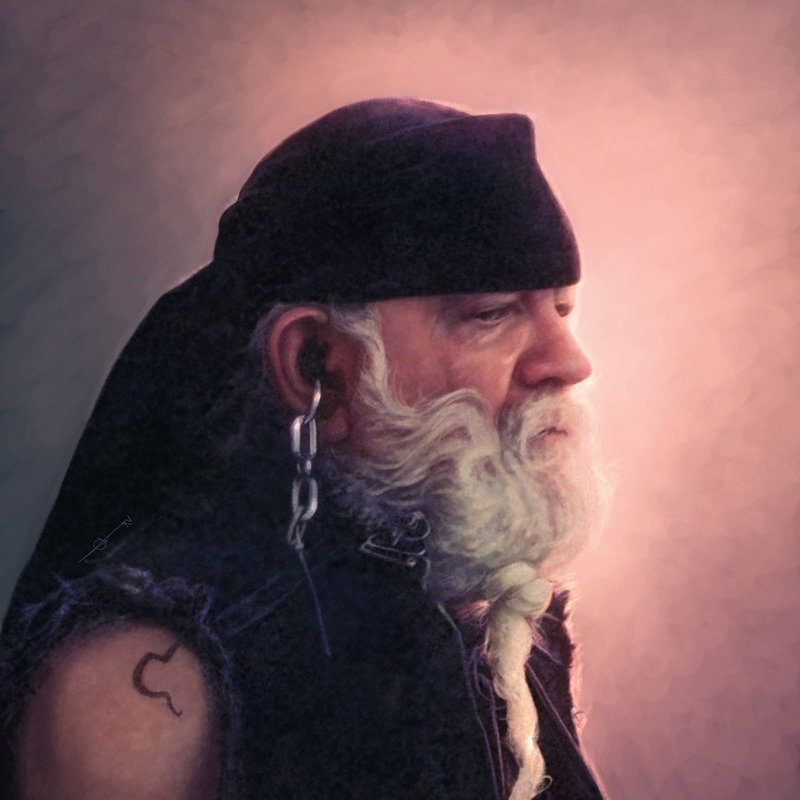 La Monte Young
La Monte Young
Tucked in the basement of Red Bull Studios, the Chelsea gallery space/HQ that hosted DiS Magazine’s DISown show, curatorial efforts by Phong Bui, and Ryder Ripps’ Alone Together installation, the near century-old father of contemporary minimalism lit incense while Ragas played through Yamaha speakers, a chorus of cameras clicking-away incessantly, droning in their own weird display of idol-worship happening IRL at the feet of the contempo-master. Despite the apparent tension between Raga music and Tuarine, La Monte Young had a calm energy that proved he had compartmentalized much of the world’s suffering neatly into the infinity of time, as his undying focus on the resounding note that extends into the cosmos allowed his talk to be just a riternello — a brief return to the new American theme he so expertly defined, expanded, and eventually avoided completely. The bravado of an energy drink (lights, camera…Red Bull) paled in comparison to his quasi-mystic charm; for Young, a fleeting capital exchange with a corporate entity was not a cause for political alarm or ethical resistance.
He talked primarily about what it means to be a student, he spoke on the seriousness of disciple-ship and the intense focus it takes to truly “know” something, about how it takes 20 years to learn only two ragas, and how his Tambura studies in India with Pandit Pran Nath forced 3-hour sleep days, where he would have to go out into the forest to practice away from his master’s sensitive ear. He told tales of Mughal emperors and Krishna and stories about hopping in vans to blow horns with Don Cherry or arguments with Morton Feldman regarding the nature of improvisation and its relationship to composition. His primary strand of thought involved how “musicians are always looking for a place to play,” a statement that developed into a conversation about how NYC’s geography and clubs harbored many sea-changes of mind in his heyday, and how his Dream House seeks to incubate similar sea changes focused on maintaining an example of the infinite plain in which sound itself extends. Moderator Alan Licht tried to his best to steer the conversation, but ultimately understood to follow Young’s conversational flow in whatever direction it desired. Artist Marian Zazeela, Young’s partner and collaborator, filled in wherever Young became too esoteric — she discussed their recent practices, as well as the Dream House’s upcoming events and search for a permanent location. Although Eno, Cale, Glass, or whoever call him the “daddy of us all,” Young made it clear he’s been swimming along in his own lane for some time now, his wisdom forever focused on sustain.
Electronic Africa
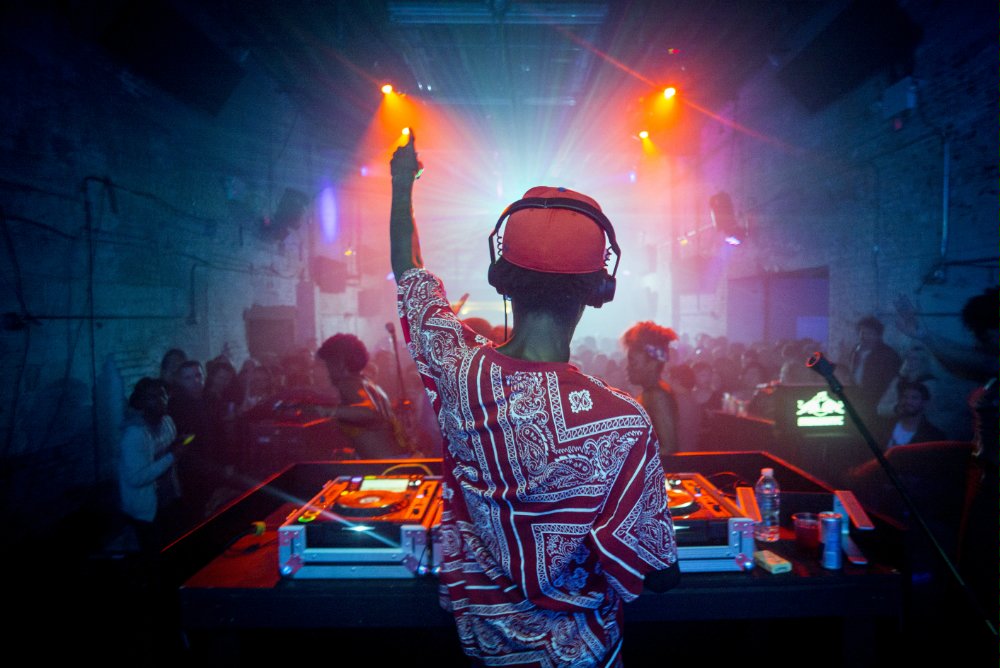 DJ Spoko
DJ Spoko
Red Bull Music Academy’s Electronic Africa showcase was held at Villain, a venue in Williamsburg I remember most vividly from about two years ago, when I saw Death Grips, had too much to drink at an open bar, and got punched in the face. I showed up right as the show was set to begin, to a mostly empty queue which filled up soon after. Inside were two small white rooms, one a performance space, the other decorated with couches and elongated drums on legs that lit up when struck — or were supposed to; they were working the kinks out. An eager man, maybe paid to do this, stood by to slap-test them, making hard thuds which shook the room with blue light. As I sat and observed, Red Bull and vodka in hand, a man asked me about the show, if I knew any of the DJs. He seemed disappointed that I was not familiar with them. I liked Nozinja, I said. He got up and wandered off.
The show began to a small crowd but had swelled to full capacity by about 30 minutes. The opening acts were infectious. DJ Spoko and Titica made use of a bevy of onstage dancers, which ran the crowd into a frenzy that matched the music’s quick BPM. Roughly around that time, there were some professional dancers who swarmed the front of the crowd and put on a show. Nozinja’s constant chant of “One! Eight! Nine!” sent pangs of joy to my head and stress to my joints. It was all chattering bass, skittering snares, and any move you made was the right one. It was all sped up and I sweated to it, and shook my hips a little, and then constantly, and fell into place. The music was relentless, voices and mingling patterns of percussion; you could drop in at any time, be enmeshed in the throng.
The Big Ass Fan wasn’t doing much to cool the crowd. I was pushed into the current, edged over to the parting where people push through with their beer cups and full bladders, impeding boogie, apologizing and elbowing each other. Kaleidoscopes erupted on stage, and up in the air behind me a silhouette of a woman danced before a sheer red curtain. Crowds in the adjacent room made conversation, and as the music and crowd grew in size and volume, their friends arrived, and the conversations continued, but louder, like the music wasn’t there and they simply always talked this way. I went outside to try and make conversation but there wasn’t any. I ejected onto the street sometime later, sweat cleansed, and briefly considered street food, but thought better of it.
GHE20G0TH1K
 Total Freedom
Total Freedom
The “final” installment of Venus X’s GHE20G0TH1K saw a slice of the world conceptually unified under her carefully engineered, vibrant maxim: celebrate death and life in equal measure. Venus packed 2,000 people into the Brooklyn Bazaar warehouse space on the same night as one of the biggest fights in history; somehow the energy of “the ring” — sweat, large (engorged) vinyl and leather fisticuff gloves, bright golden shorts with dragons on them — was transubstantiated into the leather and chains of wild dancers in steel cages, or voguers in 6-inch heel combat boots strutting powerfully onto the runway. Venus, a virtual cultural institution in-and-of-herself, translated her two-fold ideology of evoking power and safety into the design of the line up itself: it was a night celebrating Ballroom, Vogue, and New Orleans Bounce, as well as black, hispanic, female, and trans artists, a celebration that served to empower the ownership of culture, the open-sourcing of genre, and the promotion of the underrepresented. Total Freedom started the night off heavy with audio from riot police radios in Baltimore, as well as a sample of Baltimore Attorney Marilyn Mosby announcing charges against the police officers for the death of Freddie Gray.
The night moved on to a phenomenal b2b set from Asma Maroof (Ma Nguzu) and Venus X herself — which dropped their classic metallic beat-craft alongside calypso-fueled re-renderings of Fetty Wap, Thug’s “Constantly Hating,” or the set’s sublime climax, an unreal remix of Keedy Black’s masterpiece “COME INTO MY BEDROOM”. Most of the performances had a 33 1/3 split between the role of the DJs, the dance crews (who vogued and juked on a runway that jutted out into the crowd), and the constant slew of new MC’s who took the mic to deliver impromptu verses over the tumult. Sissy Nobby’s debut NYC performance was a brief, triumphant presentation of the New Orleans style she helped originate — a propulsive, upbeat deluge of sliced vocal cuts that had the whole place…bouncing. MikeQ and Divoli S’vere closed the night by soundtracking a vogue battle, as the ineffable “HA” rung into the night. Although the un-ignorable presence of the corporate “fourth-wall” (lights, camera…Red Bull) prevented the event from maintaining its complete raw potentiality, Hood By Air’s co-presenter status dressed the night into a more fitting stream of absurd/incredible outfits that caught way more attention than 1,000 brand logos.
PC Music & SOPHIE: Pop Cube
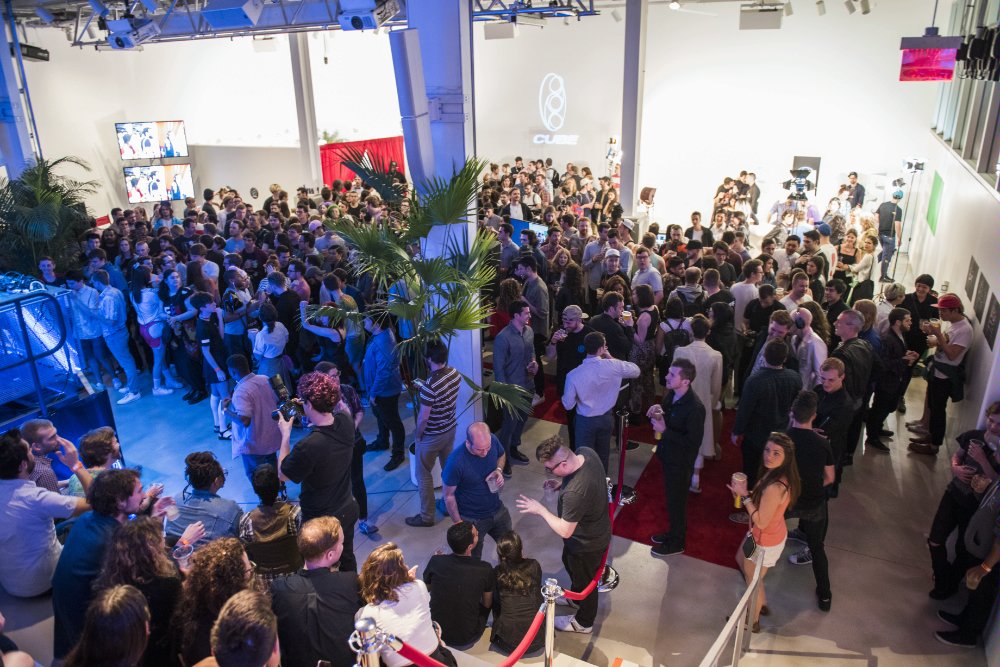 Pop Cube
Pop Cube
Upon arrival, there was a large white Cadillac SUV stretch limo blocking the road, turning in front of a large Red Bull tech-tank, with a fellah atop it yelling with his beard through sunroofs: “If you’re coming in, you’re gonna have a good time!” The line quickly filled up with future looks, completely ignoring Aaliyah, and after a few laps, the limo parked, and the PC Music crew exited to an onslaught of faux-tographers, entering BRIC, while QT adorned the Red Bull tech-tank as Caravaggio’s Basket of Fruit. After playing “Hey QT,” “Fanta,” and “Wannabe,” QT and the line began their way inside following a red carpet into a room-length staircase past two people interviewing attendees cast upon screens throughout the building as Dux Content played on a platform in the middle.
More interested in the bathroom, I ran down the stairs — nearly tripping over the interviewers’ mic cord — and asked a crew worker, Where’s the bathroom? and What are you doing here? He gave me the bathroom location and told me, “We were hired to provide accommodations for a living environment.” I thanked him, ran to the bathroom, saw and thanked SOPHIE for all that his music has done for my life in the past two years, and made it back downstairs to dance with Aaliyah, who kept claiming, “I made this song.” In one corner was a long, white, rocket ship-looking bar, and in the other was Hannah Diamond interviewing people behind a red curtain also cast upon a plethora of screens around BRIC. Another crew member told me, “I’m really just here to guard these pieces as art,” referring to everything with his arms, when suddenly Dux Content is interrupted by Blood Orange and the Unplugged with alarming audio instructions, so everyone shuffled into the main theater.
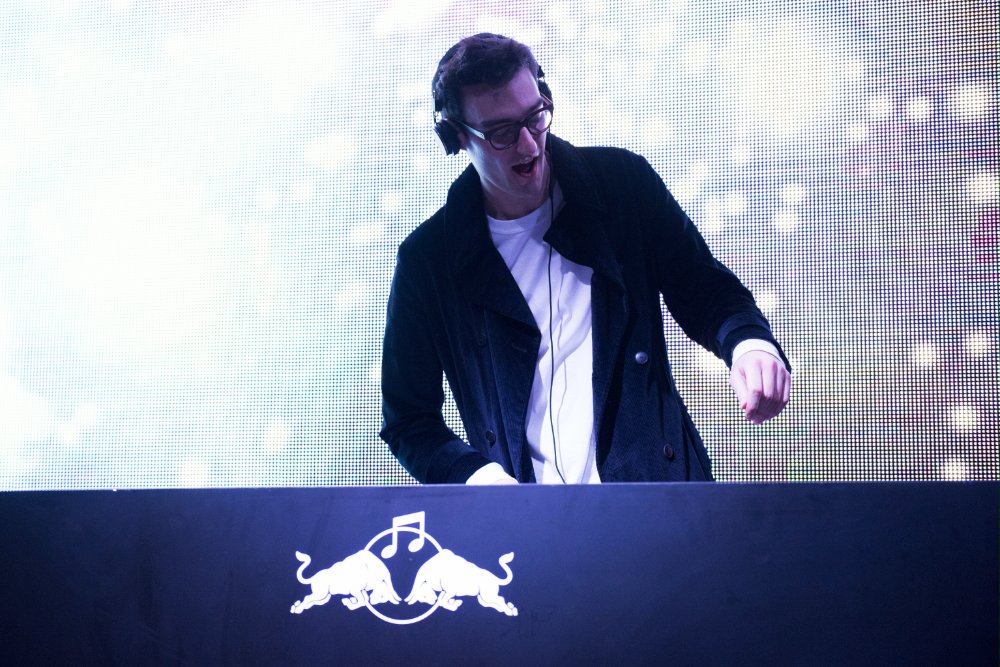 Danny L Harle
Danny L Harle
Upon entrance, Danny L Harle was geared up with d’Eon on harpsichord to the left, and three string and bow instrumentalists to the right, to which he played/fucked with audibly until the backing visuals began souring through computerized grasslands, mountains, rivers, oceans, and the sky; Danny L Harle opened the evening with a sweat that continued to fume. Once Harle ended, three Red Bull workers came out with a QT mini-fridge and stocked it full of QT drinks, as Aaliyah quietly heckled ‘em as if they were three-dudes in a deli. QT came on stage with two pals in the background, sold a few drink orders via Bluetooth, and then left after announcing when QT is available for purchase, only to come back on stage with her pals to *sing* her hit “Hey QT.” As the crowd mellowed halfway excited, savoir Hannah Diamond graced the stage, and the audience turned into a collective teen girl, panicking to glimmer a glance, as she ran down her latest catalog of singles, including “Every Night,” “Pink and Blue,” and “Drop FM.” Hannah was backed by two choreographed dancers in white, silhouetted against raining diamonds, glimmering diamonds, rotating diamonds, fuzzy diamonds, etc.
Aaliyah was interviewed in the middle of the performance by someone *from* Pop Cube, who asked what she’s wearing, and she responded “Lil B” as we made our way to the bathroom. A. G. Cook began his set on the extreme (playing piano), only to turn’t it (with minor visuals; modestly, himself) into a sweeping set of future-club tracks that completely threw out the audience’s back. d’Eon was talking at me about Red Bull paying for his Canada-to-NYC travel, A. G. Cook being the new Rraro, and renting a harpsichord to play that night; he was generally just being the nicest dude. But upon Aaliyah’s return, the three of us followed the audience into a dancing melt. Between sets, I grabbed a bottle of water, and a guy named Ollie approached me asking for pills, as I was sweating and visibly appeared to be rolling. Even though I answered NO, Ollie stuck with Aaliyah and me, as we questioned in whispers whether or not he was hired as a Pop Cube plant to push that “new social media” vibe.
 GFOTY
GFOTY
Ollie made a path for us leading all the way up front for GFOTY, as Aaliyah kept yelling for our non-existent friend “James!” in light of teamwork; New York meets London movement. And GFOTY brought the party. And a blow-up palm tree was tossed around the audience. And it was eventually taken by Ponibbi to use as a penis on the second-floor balcony to fuck the crowd (???; it was bombed-out). And there was a wind-arm Santa on the right, backed by two dancers going in hard. And GFOTY pulled off a Britney nude bikini better than Britney. And she was completely just rambling across the stage into a microphone that was overdubbing her press-play setlist, which all-in-all boosted her to an MC level of future that precedes no predecessor.
SOPHIE took her time arriving on stage, but once she was in place, the building began to shake with snarled electronic timbres until the walls and ceiling crumbled when the bass completely dropped out. Twisting knobs and flicking switches, SOPHIE created another groundbreaking mix of previous and rare new singles that — pains me to write — are unsearchable on the internet. As Aaliyah and I soakingly forgot about Ollie, we moved to the back during the middle of SOPHIE’s set, watched the entirety of BRIC shift, and as I was dancing to the lyrics “Gonna have a good time/ A good time…”, when the man with a beard from the Red Bull tech-tank from earlier told me, “You’re having a good time!”
